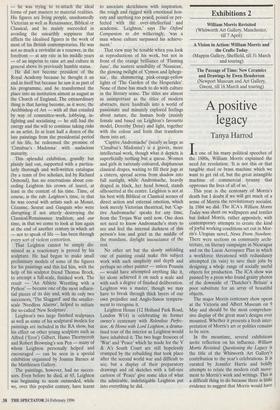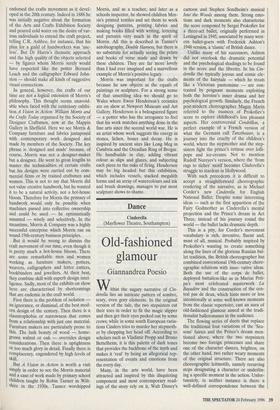Exhibitions 2
William Morris Revisited (Whitworth Art Gallery, Manchester, till 7 April) A Vision in Action: William Morris and the Crafts Today (Mappin Gallery, Sheffield, till 31 March and touring)
The Passage of Time: New Ceramics and Drawings by Ewen Henderson (Newport Museum and Art Gallery, Gwent, till 16 March and touring)
A positive legacy
Tanya Harrod
In one of his many political speeches of the 1880s, William Morris explained the need for revolution: 'It is not this or that tangible steel or brass machine which we want to get rid of, but the great intangible machine of commercial tyranny that oppresses the lives of all of us.'
This year is the centenary of Morris's death but I doubt if we will get much of a sense of Morris the revolutionary socialist. In 1984 we did. The ICA's William Morris Today was short on wallpapers and textiles but linked Morris, rather appositely, with contemporary attempts to create the kind of joyful working conditions set out in Mor- ris's Utopian novel, News From Nowhere. There were sections on community archi- tecture, on literacy campaigns in Nicaragua and on the Lucas Aerospace Plan in which a workforce threatened with redundancy attempted (in vain) to save their jobs by designing a whole range of socially useful objects for production. The ICA show was panned by a press who found grainy photos of the downside of 'Thatcher's Britain' a poor substitute for an array of beautiful objects.
The major Morris centenary show opens at the Victoria and Albert Museum on 9 May and should be the most comprehen- sive display of the great man's designs ever mounted. Whether it presents a fresh inter- pretation of Morris's art or politics remains to be seen.
In the meantime, several exhibitions invite reflection on his influence. William Morris Revisited: Questioning the Legacy is the title of the Whitworth Art Gallery's contribution to the year's celebrations. It is curated by Jennifer Harris and boldly attempts to relate the modern craft move- ment to Morris's work and writings. This is a difficult thing to do because there is little evidence to suggest that Morris would have endorsed the crafts movement as it devel- oped in the 20th century. Indeed in 1888 he was initially negative about the formation of the Arts and Crafts Exhibition Society and poured cold water on the desire of var- ious individuals to extend the craft project, telling C.R. Ashbee, for instance, that his plan for a guild of handworkers was 'use- less'. But Dr Harris's thematic approach and the high quality of the objects selected — by figures whom Morris surely would have respected like the potter Bernard Leach and the calligrapher Edward John- ston — should make all kinds of suggestive visual connections.
In general, however, the crafts of our time are not a logical extension of Morris's philosophy. This thought seems unavoid- able when faced with the centenary exhibi- tion A Vision in Action: William Morris and the Crafts Today organised by the Society of Designer Craftsmen, now at the Mappin Gallery in Sheffield. Here we see Morris & Company furniture and fabrics juxtaposed with contemporary work designed and made by members of the Society. The key phrase is 'designed and made' because, of course, Morris was not a designer-maker but a designer. He went to great lengths to master the technicalities of certain crafts but his designs were carried out by com- mercial firms or by trained craftsmen and women. This is not to say that Morris did not value creative handwork, but he wanted it to be a natural activity, not a hot-house bloom. Therefore for Morris the primacy of handwork would only be possible when machines passed into collective ownership and could be used — he optimistically assumed — wisely and selectively. In the meantime, Morris & Company was a highly successful enterprise which Morris ran on sound 19th-century business principles.
But it would be wrong to dismiss the craft movement of our time, even though it is pretty much a hot-house bloom. There are some remarkable men and women working as furniture makers, potters, weavers, calligraphers and letter cutters, bookbinders and jewellers. At their best, they combine skill with superb design intel- ligence. Sadly, most of the exhibits on show here are characterised by shortcomings that are endemic in the craft world.
First there is the problem of isolation an ignorance, or dismissal, of the best mod- ern design of the century. Then there is a claustrophobia or narrowness that comes from a relationship with just one material. Furniture makers are particularly prone to this. The lush beauty of wood — home- grown walnut or oak — overrides design considerations. Then there is uptightness or too much glory in detail. Finally there is Complacency, engendered by high levels of skill.
But A Vision in Action is worth a visit simply in order to see the Morris material and a case of work made by primary school children taught by Robin Tanner in Wilt- shire in the 1930s. Tanner worshipped Morris, and as a teacher, and later as a schools inspector, he showed children Mor- ris's printed textiles and set them to work designing patterns, printing fabrics and making books filled with writing, lettering and pictures very much in the spirit of Morris. All this is described in Tanner's autobiography, Double Harness, but there is no substitute for actually seeing the prints and books of verse made and drawn by these children. They are far more lovely than I had ever imagined and a marvellous example of Morris's positive legacy.
Morris was important for the crafts because he saw objects as the equals of paintings or sculpture. For a strong sense of that unsettling idea we should go to Wales where Ewen Henderson's ceramics are on show at Newport Museum and Art Gallery. Henderson is a beleaguered figure — a potter who has the arrogance to feel that his work matches anything done in the fine arts since the second world war. He is an artist whose work suggests the energy in stones, lichen, bones and decay. He is inspired by ancient sites like Long Meg in Cumbria and the Orcadian Ring of Brogar. He handbuilds in clay, adding vibrant colour as slips and glazes, and subjecting each piece to the risks of firing. Henderson may be big headed but this exhibition, which includes vessels, stacked megalith forms and an array of watercolours and ink and brush drawings, manages to put most sculpture shows to shame.



























































 Previous page
Previous page